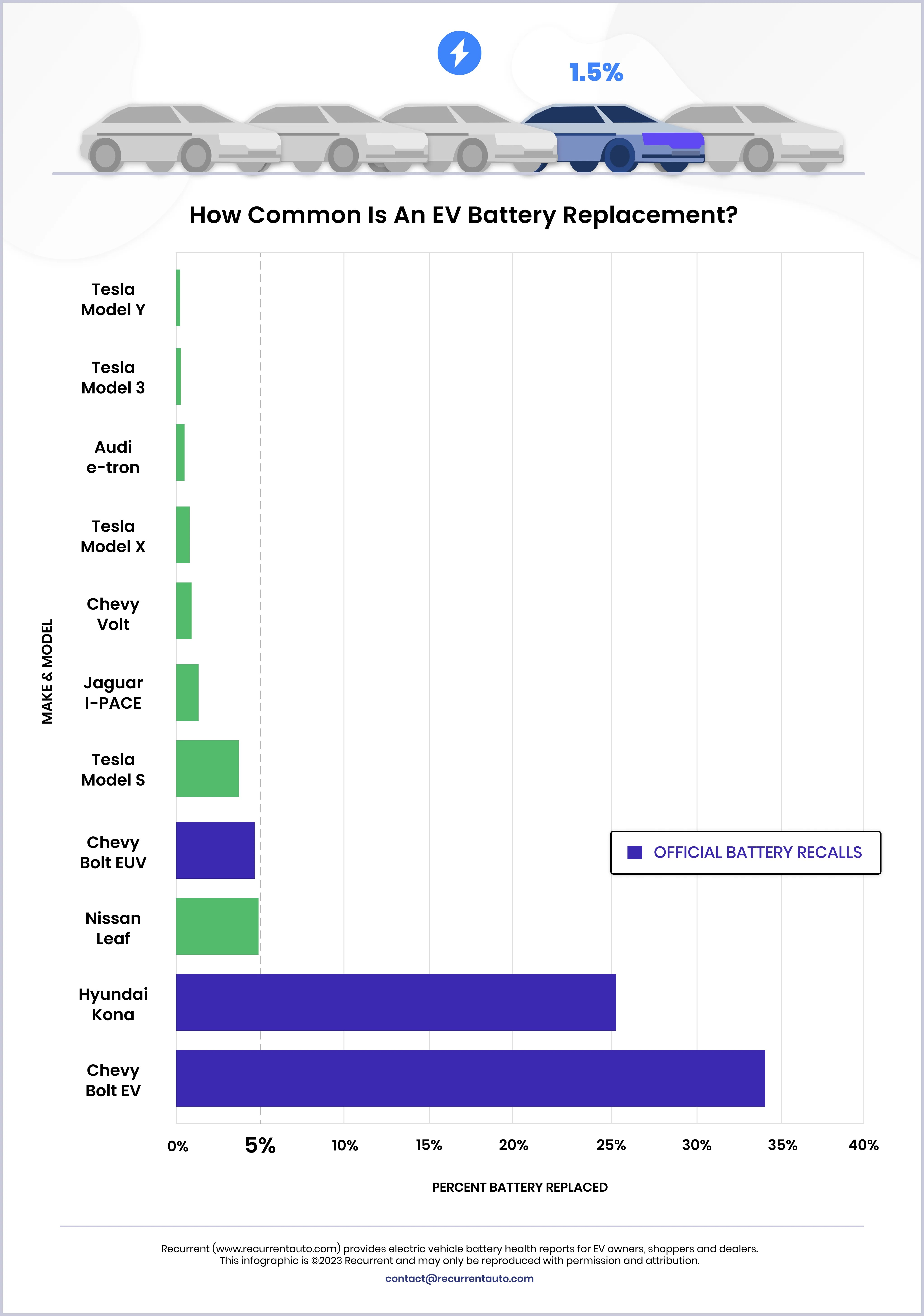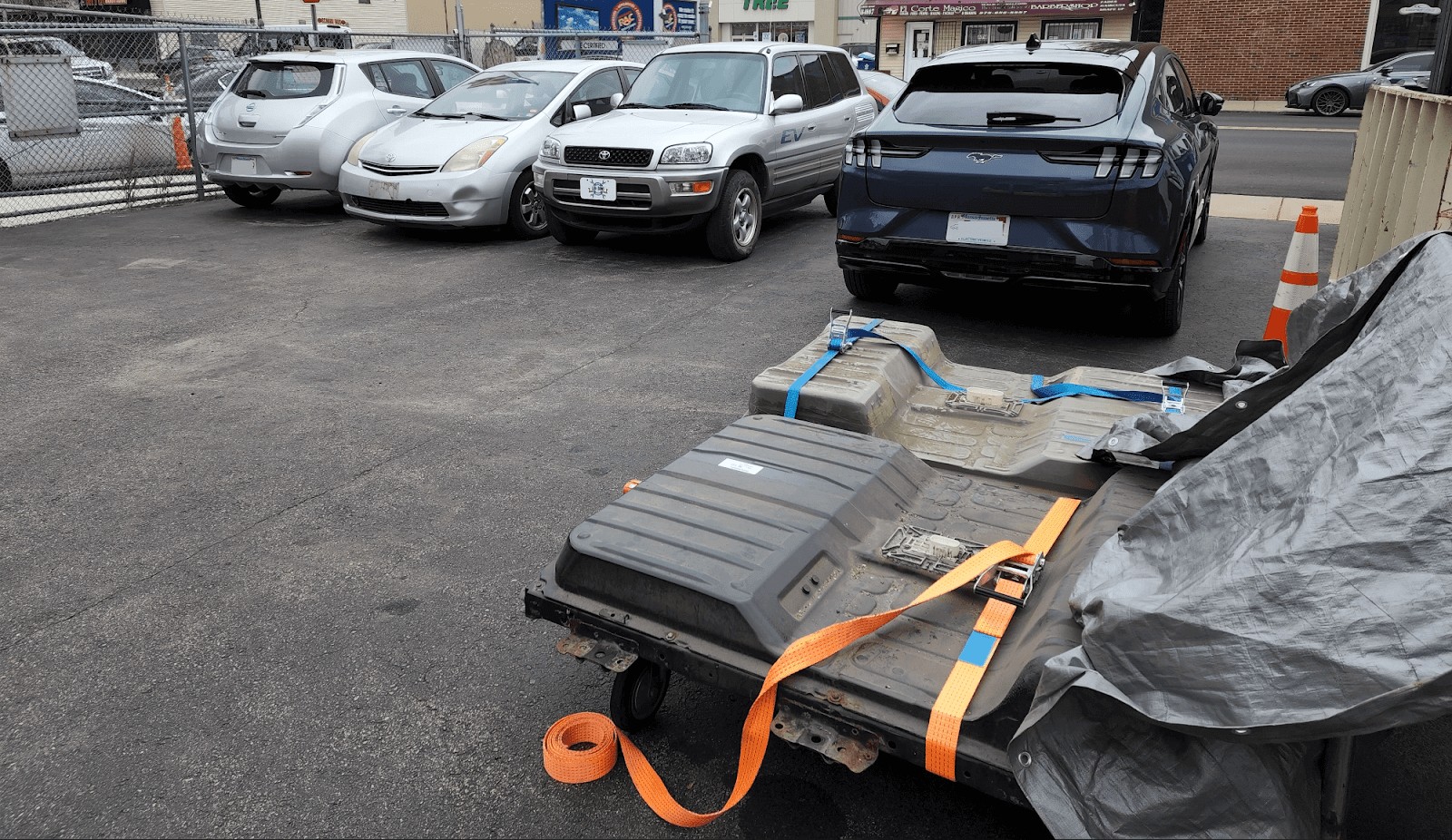Tesla battery replacement costs can range from $15,000 to $22,000 if the need arises outside the manufacturer’s warranty. At HOW.EDU.VN, we understand that this is a significant investment, and it’s essential to have all the facts. While battery issues are rare in modern Teslas, understanding the factors influencing replacement costs, battery sizes, and warranty coverage is crucial for every Tesla owner. Let’s delve into Tesla battery longevity, degradation factors, and the financial aspects of battery replacement to help you make informed decisions about your electric vehicle.
1. Understanding Tesla Battery Replacement Costs
The cost of replacing a Tesla battery can vary widely depending on several factors. These include the model of your Tesla, the battery size (measured in kilowatt-hours or kWh), and whether the replacement is covered by the manufacturer’s warranty. Generally, larger batteries cost more to replace due to the increased materials and complexity involved.
1.1. Factors Influencing Tesla Battery Replacement Costs
- Battery Size (kWh): The larger the battery capacity, the higher the replacement cost. For instance, a 100 kWh battery for a Model S or Model X will typically be more expensive than a 60 kWh battery for a Model 3.
- Tesla Model: Different Tesla models have different battery pack designs and configurations, which affect the cost of replacement.
- Warranty Coverage: If the battery replacement is within the warranty period (typically 8 years or a specific mileage), Tesla will cover the cost. However, replacements outside the warranty period will be the owner’s responsibility.
- Labor Costs: Labor costs can vary depending on the service center or third-party repair shop. Tesla service centers may have higher labor rates compared to independent shops.
- New vs. Refurbished Batteries: Opting for a refurbished battery can be a more cost-effective solution compared to a brand-new battery pack.
- Location: Regional differences in labor rates and parts availability can also impact the overall cost of battery replacement.
1.2. Tesla Battery Sizes and Models
Tesla has used various lithium-ion battery formats over the years. Early models like the Roadster and Model S used 18650-style cells, while newer models like the Model 3 and Model Y may use 2170- or 4680-style cells, depending on where they were manufactured. The kilowatt-hour (kWh) capacity of the battery pack is what most drivers are concerned with, as it determines the vehicle’s range.
| Battery Size (kWh) | Sample Model | Sample Trim |
|---|---|---|
| 60 kWh | Model 3 | Standard Range |
| 75 kWh | Model Y | Long Range |
| 100 kWh | Model S | Performance |
| 100 kWh | Model X | Long Range |



1.3. The Tesla 12-Volt Battery
It’s essential to distinguish between the main propulsion battery and the 12-volt battery in a Tesla. The 12-volt battery powers accessories and security systems, while this article focuses on the larger, more expensive propulsion battery.
2. Tesla Battery Warranty Coverage
Tesla provides a battery warranty of 8 years or a specific mileage (100,000 miles for standard range trims, 120,000 miles for long range trims). If the battery degrades by more than 30% within this period, Tesla will replace it. It’s important to note that the replacement may not necessarily be a brand-new battery but one that exceeds the 70% capacity threshold.
2.1. Transferability of Tesla Warranties
Warranties that are still in effect (typically 4 years/50,000 miles) can be transferred when a vehicle is sold. Used Teslas purchased from the manufacturer often have an additional year of warranty coverage.
2.2. Tesla Battery Longevity Expectations
According to Elon Musk, the expected battery lifetime for the Model 3 is around 360,000 miles for the standard range and 465,000 miles for the long range. Many high-mileage Model 3s still maintain at least 90% battery capacity, indicating the durability of Tesla batteries.
3. Common Reasons for Tesla Battery Replacement
Tesla batteries are known for their longevity, but they can still degrade over time. The primary reasons for battery replacement include:
3.1. Capacity Fade
Capacity fade refers to the gradual degradation of battery elements, leading to a reduction in the total available energy in the battery. This results in a decrease in the vehicle’s range.
3.2. Power Fade
Power fade focuses on the battery’s ability to discharge energy quickly, affecting acceleration performance. Drivers may notice sluggishness in the vehicle’s acceleration.
3.3. Tesla Battery Degradation Data
Real-world data from Tesla Model 3 and Model S vehicles show that range loss is limited, especially after the initial years. This demonstrates the resilience of Tesla batteries over time.
4. Tesla Battery Replacement Options
When it comes to replacing a Tesla battery, there are several options to consider:
4.1. Tesla Service Centers
Tesla Service Centers are the most common option for battery replacements, especially for those covered under warranty.
4.2. Third-Party Battery Replacement Shops
Third-party shops are becoming increasingly popular, offering more options to drivers. These shops may provide battery pack repairs or used battery packs. Companies like The Electrified Garage and Gruber Motor Company specialize in Tesla battery work.
4.3. Refurbished Tesla Batteries
Opting for a refurbished battery can be a more cost-effective alternative to a new battery pack. These batteries have been inspected and restored to a functional condition.
5. Tesla Model-Specific Battery Replacement Costs
The cost of replacing a Tesla battery varies depending on the model. Here’s a breakdown of the estimated costs for different models:
5.1. Tesla Model S Battery Replacement Cost
The Tesla Model S has been on the market since 2012, with various model years and battery sizes. This makes it challenging to provide a precise battery replacement cost.
- Battery Cost: $12,000 – $15,000
- Labor Cost: Varies
- Total Cost: $20,000 – $22,000
5.2. Tesla Model 3 Battery Replacement Cost
The Tesla Model 3 is one of the most popular electric vehicles globally. Battery replacements are rare, but some reports indicate a cost per kWh of $180 plus labor.
- Battery Cost: $13,500+
- Labor Cost: $2,299.27
- Total: $15,799.27
5.3. Tesla Model Y Battery Replacement Cost
The Tesla Model Y shares similar configurations with the Model 3, including the battery packs. The replacement cost is expected to be similar to the Model 3, around $15,000.
6. Tips to Prolong Tesla Battery Life
To avoid costly battery replacements, consider these preventative measures:
6.1. Optimal Charging Habits
Avoid consistently charging the battery to 100% or depleting it to 0%. Instead, maintain a charge level between 20% and 80% for daily use.
6.2. Minimize Fast Charging
While fast charging is convenient, frequent use can generate heat and accelerate battery degradation. Use fast charging sparingly.
6.3. Control Temperature
Extreme temperatures can impact battery health. Park in shaded areas during hot weather and use the vehicle’s preconditioning feature to regulate battery temperature.
6.4. Reduce Aggressive Driving
Aggressive acceleration and high speeds can strain the battery. Drive conservatively to reduce stress on the battery pack.
6.5. Regular Software Updates
Tesla’s software updates often include improvements to battery management and efficiency. Keep your vehicle’s software up to date.
7. Navigating Tesla Battery Health with HOW.EDU.VN
Understanding the intricacies of Tesla battery health, replacement costs, and preventative maintenance can be overwhelming. At HOW.EDU.VN, we connect you with leading experts, including PhDs and specialists in electric vehicle technology, who can provide personalized guidance and solutions.
7.1. Expert Consultations on Tesla Battery Issues
Our experts offer in-depth consultations to address your specific concerns about Tesla battery health. Whether you’re experiencing range loss, performance issues, or simply want to understand how to optimize battery life, our team is here to help.
7.2. Customized Maintenance Plans for Your Tesla
We develop customized maintenance plans tailored to your Tesla model and driving habits. These plans include best practices for charging, temperature management, and driving techniques to prolong battery life and minimize the risk of costly replacements.
7.3. Real-Time Battery Health Monitoring and Analysis
Our experts can help you set up real-time battery health monitoring systems to track key metrics like capacity, voltage, and temperature. By analyzing this data, we can identify potential issues early and recommend proactive measures to prevent further degradation.
7.4. Access to Cutting-Edge Research and Insights
HOW.EDU.VN provides access to the latest research and insights on electric vehicle battery technology. Our experts stay up-to-date with advancements in battery chemistry, thermal management, and charging infrastructure to offer you the most informed advice.
8. Addressing Your Tesla Battery Concerns with HOW.EDU.VN
At HOW.EDU.VN, we understand the challenges Tesla owners face when it comes to battery health and replacement costs. Our mission is to provide you with the expertise and support you need to make informed decisions and keep your electric vehicle running smoothly.
8.1. Connecting You with Top Experts
We connect you directly with PhDs and specialists who have extensive experience in electric vehicle battery technology. These experts can provide personalized consultations, answer your questions, and offer practical solutions tailored to your specific needs.
8.2. Saving You Time and Money
Our services save you valuable time and money by providing access to trusted experts who can quickly diagnose issues and recommend cost-effective solutions. Avoid the hassle of searching for reliable information and the risk of making costly mistakes.
8.3. Ensuring Confidentiality and Trust
We prioritize the confidentiality and security of your information. Our experts adhere to strict ethical standards and maintain the highest level of professionalism in all interactions.
8.4. Providing Practical, Actionable Advice
Our experts provide practical, actionable advice that you can implement immediately to improve your Tesla’s battery health and performance. Whether it’s optimizing charging habits, managing temperature, or addressing specific issues, we’re here to help you achieve your goals.
9. Optimizing Your Tesla Battery for Longevity
Maximize the lifespan of your Tesla battery with these expert-recommended strategies:
9.1. Smart Charging Practices
- Daily Charging: Aim to keep your battery charge between 20% and 80% for daily use. This reduces stress on the battery cells.
- Avoid Extremes: Minimize charging to 100% and discharging to 0%, as these extremes can accelerate degradation.
- Scheduled Charging: Use Tesla’s scheduled charging feature to charge during off-peak hours, reducing electricity costs and grid strain.
9.2. Temperature Management
- Preconditioning: Use Tesla’s preconditioning feature to warm up or cool down the battery before driving, especially in extreme temperatures.
- Parking: Park in shaded areas during hot weather to prevent overheating.
- Garage Storage: Store your Tesla in a garage or covered area to protect it from temperature fluctuations.
9.3. Driving Habits
- Gentle Acceleration: Avoid aggressive acceleration and hard braking, which can strain the battery.
- Consistent Speed: Maintain a consistent speed on highways to improve energy efficiency.
- Regenerative Braking: Utilize Tesla’s regenerative braking feature to recapture energy and extend range.
9.4. Battery Monitoring
- Tesla App: Use the Tesla app to monitor battery health, charging status, and energy consumption.
- Third-Party Apps: Consider using third-party apps that provide more detailed battery health data and analytics.
- Regular Checkups: Schedule regular checkups with a Tesla service center to assess battery health and address any potential issues.
10. The Future of Tesla Battery Technology
Tesla is continuously innovating in battery technology to improve performance, longevity, and cost-effectiveness. Some of the key areas of development include:
10.1. New Battery Chemistries
Tesla is exploring new battery chemistries, such as lithium iron phosphate (LFP) and solid-state batteries, to enhance energy density, thermal stability, and cycle life.
10.2. 4680 Cells
Tesla’s 4680 cells are designed to increase energy density and reduce manufacturing costs. These cells are expected to play a significant role in future Tesla vehicles.
10.3. Battery Recycling
Tesla is investing in battery recycling technologies to recover valuable materials from end-of-life batteries and reduce environmental impact.
10.4. Over-the-Air Updates
Tesla’s over-the-air software updates can improve battery management, charging efficiency, and overall vehicle performance.
11. FAQ: Your Questions About Tesla Battery Replacement Answered
11.1. How often do Tesla batteries need to be replaced?
Tesla batteries are designed to last for many years and miles. Replacements are relatively rare, especially within the warranty period.
11.2. What is the warranty on a Tesla battery?
Tesla provides an 8-year or specific mileage warranty (100,000 miles for standard range, 120,000 miles for long range).
11.3. Can I replace my Tesla battery with a larger capacity battery?
Upgrading to a larger capacity battery may be possible, but it depends on the vehicle model and compatibility. Consult with Tesla or a qualified third-party shop.
11.4. What is the difference between a new and refurbished Tesla battery?
A new battery is brand new, while a refurbished battery has been inspected and restored to a functional condition. Refurbished batteries are typically more cost-effective.
11.5. Can I replace my Tesla battery at a third-party shop?
Yes, there are third-party shops that specialize in Tesla battery replacements and repairs.
11.6. How long does it take to replace a Tesla battery?
The replacement process can take several hours to a full day, depending on the shop and the complexity of the job.
11.7. Will replacing my Tesla battery improve its range?
If the replacement battery has a higher capacity than the original, it can improve the vehicle’s range.
11.8. How do I know if my Tesla battery needs to be replaced?
Signs of battery degradation include reduced range, frequent charging, and performance issues.
11.9. What happens to my old Tesla battery after it is replaced?
Tesla recycles old batteries to recover valuable materials and reduce environmental impact.
11.10. Is it worth replacing a Tesla battery?
Whether it’s worth replacing a Tesla battery depends on the vehicle’s condition, the cost of replacement, and your driving needs. Consult with an expert to determine the best course of action.
12. Ready to Optimize Your Tesla’s Battery Health?
Don’t let battery concerns hold you back from enjoying your Tesla. Contact HOW.EDU.VN today to connect with leading experts who can provide personalized guidance and solutions. Our team is dedicated to helping you optimize your Tesla’s battery health, extend its lifespan, and minimize the risk of costly replacements.
12.1. Contact Us Today
- Address: 456 Expertise Plaza, Consult City, CA 90210, United States
- WhatsApp: +1 (310) 555-1212
- Website: how.edu.vn
12.2. Schedule Your Consultation
Schedule a consultation with one of our expert PhDs today and take the first step towards optimizing your Tesla’s battery health. We’re here to help you make informed decisions and keep your electric vehicle running smoothly for years to come.
